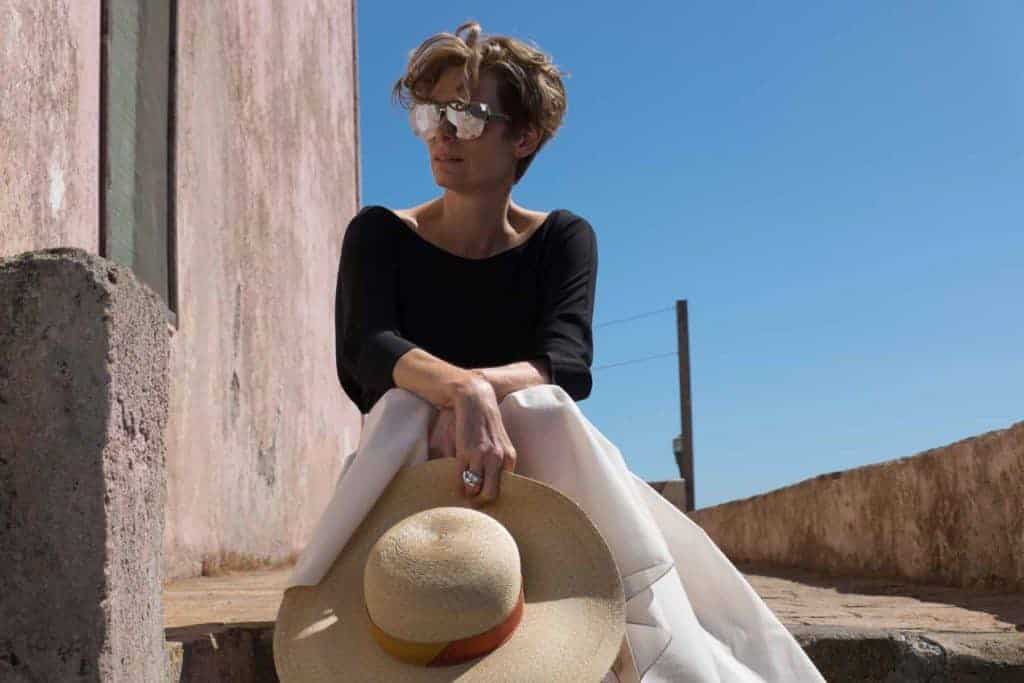Explicitly playing with gender and gender performance has been foundational to Swinton’s career and identity as a performer. Swinton’s queer identity emerges from a person who is both presumptively heterosexual and who has largely chosen presumptively heterosexual roles. So what makes her a queer cult figure? This is the 3rd feature in our special A Bigger Splash week.

Regal, alien, alone, Orlando looks into the mirror at their reflection, takes their hand, briefly feeling their face, moving slowly downwards. Then Orlando’s eyes shift, looking directly at the audience. We are transfixed. The titular immortal noble Orlando, in Sally Potter’s adaptation of Virginia Woolf’s novel of the same name, spends the first half of the film as male and then transitions to female overnight, navigating their identity and place in an ever-changing world. As Orlando explores their new gender, the mystical, queer appeal of Tilda Swinton bursts through the screen.
Though Orlando is Swinton’s most famous queer role, her appeal as an icon lies in how she deliberately “queers” even conventional cinema. There are no performers like the otherworldly, genre- and gender-bending Swinton. As writer and activist Shon Faye puts it, queerness is “a question. It is a side eye and a challenge back to mainstream politics. It says, ‘I don’t know the answer, but why are you asking the question?’”
Born Katherine Matilda Swinton on November 5, 1960, she spent much of her early acting career in theatre, including time at the Royal Shakespeare Company. Now the actress, model, performance artist, icon is best known as a kind of cult figure. Swinton oscillates between mainstream and arthouse film, between the accessible and the avant garde, the normative and the queer milieus; she’s worked with auteurs like Sally Potter, the Coen Brothers, Lynne Ramsay, and Derek Jarman, always adding her signature voice to their films. Swinton rarely abides by normative roles and concepts of identity. When she does, it is with a wink of cultural critique.
As the epitome of androgyny, Swinton challenges mainstream conventions extra-textually. She often wears relatively short blonde hair, and her large, expressive eyes dominate her face. Her perfectly sculpted cheekbones lack the softness of femininity, and then there’s her uniquely penetrating stare. Being coded as masculine and/or feminine is the essence of to Swinton’s appeal. Swinton’s looks are a microcosm of her artistic persona, the way she seems to transcend our conventional notions of gender, gender coding, and gender presentation. Her performative quality, in both arthouse and mainstream films, is anarchic to the very institutions and constructs that usually confine actors.
Swinton’s work with English queer filmmaker and artist Jarman, starting with Carvaggio (1986), would be crucial to establishing her cultural identity as someone interested in characters who are fluid and unimpeded by binaries or boundaries. Swinton’s work with Jarman on The Last of England (1987), War Requiem (1989), and Edward II (1991) expanded on these themes of constructing identity. The two merged the political and the personal in their collaborations, examining national identity, the identity of trauma, and the assignation of iconography and its dissolution.
After working with Sally Potter on Orlando, Swinton swung into the mainstream with The Deep End (2001), The Beach (2000), The Chronicles of Narnia: The Lion, the Witch, and the Wardrobe (2005), and her Oscar-winning role in Michael Clayton (2007). Through her arty and mainstream work,she imbues her characters with a sense of the alien,regardless of the director she’s working with or the role. (She once joked, “My aesthetic North Stars, the individuals with whom I share the same planetary DNA.”)
Using her body (of work) to chip away at normative ideas, like gender and sexual binaries, is Swinton’s trademark, one she initiated in Sally Potter’s Orlando. Swinton has called what she did in the film a “non-performance”(Schwartz). In an interview with David Schwartz for the Museum of the Moving Image, she elaborated, “Trying to sort of eradicate anything that might stand in the way of the relationship between Orlando and the audience, was very important to us.” Dan Kois of Slate noted, “time and again, Swinton’s Orlando looks straight into our eyes…bemused by the chaos of centuries surrounding her”.
Part of this “chaos of centuries” includes the transformation of gender and society. For in the diegesis of Orlando’s world, and in the reality of Swinton’s, the ways in which gender is performed have changed, though technically “centuries” separate them. Orlando is able to perform masculinity and femininity and watch its effects on the people around them and on the audience. Reading from Shakespeare and Spenser, Swinton looks into the camera and exists as a being for whom binaries are useless, and the spiritual quality of art itself serves as the primary framework for self-identification.
Explicitly playing with gender and gender performance has been foundational to Swinton’s career and identity as a performer. Her role in Bong Joon-ho’s adaptation of the graphic novel Snowpiercer, as Deputy-Minister Mason, was originally written for a man. Although Bong adjusted the character in the screenplay, Swinton was, again, able to work outside the parameters of a binary system. Mason, one of the primary arbiters of a social caste system in the film, is neither demasculinized nor defeminized; the power madness is genderless.
Swinton’s queer sensibility extends beyond film: in March 2013, Swinton starred in a performance art installation at the Museum of Modern Art in Manhattan called The Maybe (1995/2013), where she slept on a nondescript bed in an unremarkable glass box. The work was a restaging of an installation she co-created with Cornelia Parker in the early 1990s. Swinton’s own appropriation of the piece — using a body (hers) that defies categorization — suggests that the queer body is something to be boxed in and looked at, rather than lived or experienced far from voyeurs.

Swinton has never explicitly identified herself as LGBTQ, yet her work, including The Maybe, seems to be intrinsic to the queer community’s artistic and cultural history. Nevertheless, Swinton’s queer identity emerges from a person who is both presumptively heterosexual and who has largely chosen presumptively heterosexual roles. Save for Orlando, none of her characters have been discernibly LGBTQ. The question becomes, can a straight person be queer? Writer and activist Shon Faye investigated this idea, and her deconstruction of queerness ended with, as she says, “a question.” Swinton, regardless of her personal identity or that of her characters, actively transcends labels and embraces the fluidity of identity. Faye quips, “Queer [as a slur] is about what you are told you are, whether you are abnormal or you simply do not recognize yourself in the narrativized normal that society tells you about.” Swinton refuses to listen to what people tell her she is.
The parody Twitter account @NotTildaSwinton (created by Elu Yudin and Carey O’Donnell in 2012) capitalizes on Swinton’s embrace of Otherness as a form of power in its own right from its first tweet: “The eclipse has given me much power. My skin glows. Tonight I feast on large game.” Swinton’s Otherness evolves into Otherworldliness. In the ironic, yet somewhat earnest words of @NotTildaSwinton, “I descend into my grotto. My gills flick out of my neck and provide me with oxygen as I gather seaweed for tomorrow’s brunch.” It almost suggests that Swinton has always been a part of the earth and yet never visible — not unlike queer people.
Gendered power is often written or conceived with a sense of Otherness, as seen in roles like Queen Christina or even Mildred Pierce. Those films focus on the reclamation of female power within a heteronormative, patriarchal societ. The White Witch, carved and performed with precision, feels very much like progeny of such roles. The character, ferocious and icy, falls into a long line of powerful female roles that appeal to queer culture. She evokes the strength of Bette Davis, Joan Crawford, and Marlene Dietrich, the latter of whom most explicitly embraced a certain masculine quality about her. Carefully controlled, and camp in just the right way (Swinton would be, of all people, singularly aware of artifice), the White Witch hones in on these pieces of female iconography within queer subculture, allowing Swinton to be in on the joke when it comes to the absurdities of gendered power.
Among the most prominent aspects of Swinton’s queer identity is her personal and artistic connection to David Bowie. She shared a similar aesthetic to the British glam rock icon: both used their androgyny to comment on social constructs. In an interview with The Daily Beast, Swinton noted, “He just looked like me, and looked like someone from the same planet as I did, and that was a great comfort to me at the time when I was 13 and 14 looking like that, that someone not only looked like that, but felt proud enough to stick themselves on the front of an album with a zig-zag across their face and a dewy collarbone” (Stern). She starred as Bowie’s spouse in his music video for “The Stars (Are Out Tonight)”, a short that allows them to exchange identities, to express gender interchangeably, and to engage in a dialogue about queerness that has spanned both of their careers.
While Bowie came out as bisexual in 1976, he admitted later that, to some degree, he regretted that decision. His artistry, like Swinton’s, spoke for itself: their desire to eschew conventions and become subsumed by queerness itself. For much of Bowie’s career as a musician and actor, speculation about Bowie’s identity mattered little compared with the way he articulated his queerness through his aesthetic, music, and acting. When Bowie and Swinton look at each other in the music video, they are acknowledging an unspoken understanding. It’s not merely persona swapping, but a kind of Bergman-esque merging of identities.
Tilda Swinton and her work shrug off the pedestrian need for easily defined social codes. Part of her otherworldliness perhaps taps into that very lack of adequate definition. And part of the queerness of that appeal is this resistance to or rejection of being labeled at all.
After this essay about Tilda Swinton’s queer cult stardom, read more from A Bigger Splash week
Read Alex Heeney’s review of A Bigger Splash.
Read our interview with Director Luca Guadagnino.
Read Dave Crewe on how Dakota Johnson challenges Hollywood femininity.
Read Alex Heeney on Matthias Schoenaerts and the art of not speaking.

